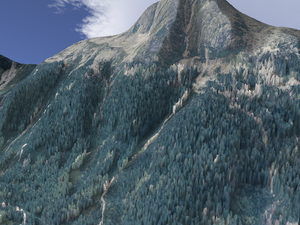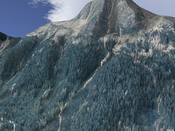Information
- Publication Type: Conference Paper
- Workgroup(s)/Project(s):
- Date: November 2006
- Lecturer:
- Booktitle: Proceedings of Graphite 2006
- Conference date: 29. November 2006 – 2. December 2006
- Keywords: real-time rendering, gpu ray casting
Abstract
This paper demonstrates the simple yet effective usage of height fields for interactive landscape visualizations using a ray casting approach implemented in the pixel shader of modern graphics cards. The rendering performance is output sensitive, i.e., it scales with the number of pixels rather than the complexity of the landscape. Given a height field of a terrain and a topographic map or similar data as input, the vegetation cover is extracted and stored on top of the height field in a preprocess, enhancing the terrain with forest canopies or other mesostructure. In addition, enhanced illumination models like shadowing and ambient occlusion can be calculated at runtime with reasonable computational cost, which greatly enhances the scene realism. Finally, including the presented technique into existing rendering systems is relatively simple, mainly consisting of data preparation and pixel shader programming.Additional Files and Images
Weblinks
No further information available.BibTeX
@inproceedings{Mantler-06-landscape,
title = "Interactive Landscape Visualization Using GPU Ray Casting",
author = "Stephan Mantler and Stefan Jeschke",
year = "2006",
abstract = "This paper demonstrates the simple yet effective usage of
height fields for interactive landscape visualizations using
a ray casting approach implemented in the pixel shader of
modern graphics cards. The rendering performance is output
sensitive, i.e., it scales with the number of pixels rather
than the complexity of the landscape. Given a height field
of a terrain and a topographic map or similar data as
input, the vegetation cover is extracted and stored on top
of the height field in a preprocess, enhancing the terrain
with forest canopies or other mesostructure. In addition,
enhanced illumination models like shadowing and ambient
occlusion can be calculated at runtime with reasonable
computational cost, which greatly enhances the scene
realism. Finally, including the presented technique into
existing rendering systems is relatively simple, mainly
consisting of data preparation and pixel shader programming.",
month = nov,
booktitle = "Proceedings of Graphite 2006",
keywords = "real-time rendering, gpu ray casting",
URL = "https://www.cg.tuwien.ac.at/research/publications/2006/Mantler-06-landscape/",
}

 paper
paper
